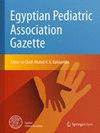Tenascin-C:作为风湿性心脏病的诊断性生物标志物
IF 0.5
Q4 PEDIATRICS
引用次数: 0
摘要
风湿热是一种长期的炎症性疾病,如果a群-溶血性链球菌没有得到足够的治疗,就会发生。风湿热是全球公认的儿童心脏病的主要原因。这种疾病会破坏心肌,使其结构逐渐恶化,并随着时间的推移损害其瓣膜的功能。本研究的目的是确定血清tenascin-C在急性风湿热和慢性风湿性心脏病诊断中的作用。这项病例对照研究涉及60名埃及儿童。其中,20人被诊断为急性风湿热,使用2015年更新的琼斯标准确诊。另外20名患有慢性风湿性心脏病的儿童也被作为研究的一部分。其余20名参与者,年龄和性别匹配的健康儿童,作为对照组。与对照组相比,急性风湿热(ARF)组血清tenascin-C水平显著升高,慢性风湿性心脏病(CRHD)组血清tenascin-C水平极显著升高(P = 0.04, 0.01)。研究组之间和组内血清腱球蛋白c的平均值有高度显著性差异。ARF、CRHD和对照组血清tenascin-C平均值分别为4.82±18.7、5.46±1.6和3.78±2.4,P = 0.02。严重二尖瓣功能不全患者血清tenascin-C水平较低。血清tenascin-C水平与c反应蛋白(CRP)、ESR、ASO滴度无显著相关性,p值均大于0.5。ARF患者血清tenascin-C的ROC曲线为曲线下面积= 0.682 (P = 0.05),最佳血清tenascin-C截断点> 3.76 ng/ml;CRHD患者血清tenascin-C的ROC曲线为AUC = 0.73 (P = 0.01),截点水平为73.76 ng/ml。ARF和CRHD患者血清tenascin-C水平升高。血清tenancin-C在诊断ARF方面优于CRP、ESR和ASOT。Tenascin-C水平可作为ARF和CRHD的诊断指标。本文章由计算机程序翻译,如有差异,请以英文原文为准。
Tenascin-C: as a diagnostic biomarker for rheumatic heart disease
Rheumatic fever is a long-term inflammatory disease that can happen if group A beta-hemolytic streptococci bacteria are not treated well enough. Rheumatic fever is recognized globally as the leading cause of heart disease in the pediatric population. This disease destroys the heart muscle, progressively deteriorating its structure and impairing the function of its valves over time. The aim of this study is to determine the role of serum tenascin-C in the diagnosis of acute rheumatic fever and chronic rheumatic heart disease. This case–control study involved a group of 60 Egyptian children. Among them, 20 were diagnosed with acute rheumatic fever, identified using the updated Jones criteria from 2015. Another 20 children, who were suffering from chronic rheumatic heart disease, were also act as a part of the study. The remaining 20 participants, healthy children carefully matched in age and sex, served as the control group. Serum tenascin-C level was significantly increased in acute rheumatic fever (ARF) and highly significantly increased in chronic rheumatic heart disease (CRHD) groups when compared with control group (P = 0.04, 0.01), respectively. There were highly significant difference between and within the studied groups regarding the mean of serum tenascin-C. Serum tenascin-C mean of ARF, CRHD, and control was 4.82 ± 18.7, 5.46 ± 1.6, and 3.78 ± 2.4, respectively, P = 0.02. Level of serum tenascin-C was lower in cases with severe mitral valve insufficiency. No significant link was found between the level of serum tenascin-C and C-reactive protein (CRP), ESR, and ASO titer, with a P-value greater than 0.5. ROC curve for serum tenascin-C in ARF patients was area under the curve = 0.682 (P = 0.05) with optimal serum tenascin-C cut-off point (> 3.76 ng/ml); ROC curve for serum tenascin-C in CRHD patients was AUC = 0.73 (P = 0.01) with cut-off point level (73.76 ng/ml). Patients with ARF and CRHD have increased level of serum tenascin-C. Serum tenancin-C is superior in the diagnosis of ARF in comparison to CRP, ESR, and ASOT. Tenascin-C level can be used as a diagnostic marker for ARF and CRHD.
求助全文
通过发布文献求助,成功后即可免费获取论文全文。
去求助
来源期刊

Egyptian Pediatric Association Gazette
PEDIATRICS-
自引率
0.00%
发文量
32
审稿时长
9 weeks
期刊介绍:
The Gazette is the official journal of the Egyptian Pediatric Association. The main purpose of the Gazette is to provide a place for the publication of high-quality papers documenting recent advances and new developments in both pediatrics and pediatric surgery in clinical and experimental settings. An equally important purpose of the Gazette is to publish local and regional issues related to children and child care. The Gazette welcomes original papers, review articles, case reports and short communications as well as short technical reports. Papers submitted to the Gazette are peer-reviewed by a large review board. The Gazette also offers CME quizzes, credits for which can be claimed from either the EPA website or the EPA headquarters. Fields of interest: all aspects of pediatrics, pediatric surgery, child health and child care. The Gazette complies with the Uniform Requirements for Manuscripts submitted to biomedical journals as recommended by the International Committee of Medical Journal Editors (ICMJE).
 求助内容:
求助内容: 应助结果提醒方式:
应助结果提醒方式:


